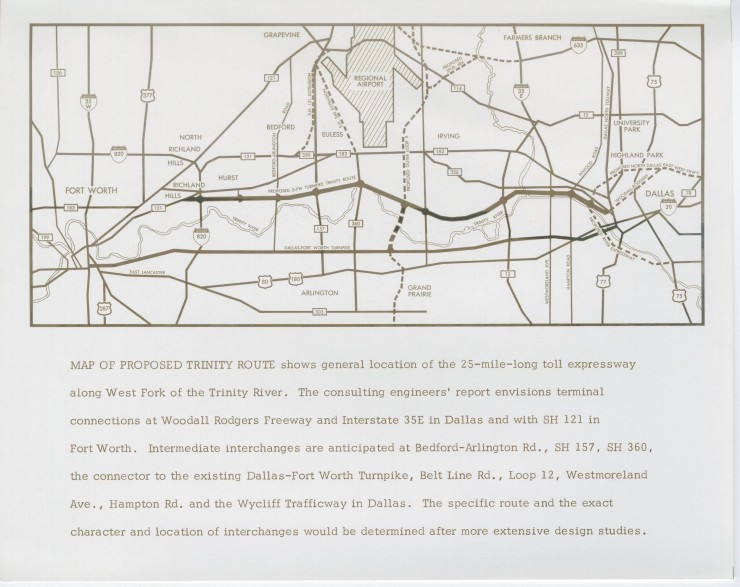 It may be difficult to believe that, until 1966, a non-stop route between eastern Dallas and western Fort Worth didn’t exist. Today, the highways connecting the two cities, as well as all the cities in between them, make Dallas-Fort Worth inseparable. The two stretches of road that contributed most to this feat are the Dallas-Fort Worth Turnpike, which opened in 1957, and Interstate 20, which was completed in early 1966.
It may be difficult to believe that, until 1966, a non-stop route between eastern Dallas and western Fort Worth didn’t exist. Today, the highways connecting the two cities, as well as all the cities in between them, make Dallas-Fort Worth inseparable. The two stretches of road that contributed most to this feat are the Dallas-Fort Worth Turnpike, which opened in 1957, and Interstate 20, which was completed in early 1966.
The relatively young Texas Turnpike Authority (TTA) had overseen two successful projects since its establishment in 1953: the Dallas-Fort Worth Turnpike, which opened in 1957, and the Dallas North Tollway, which opened in 1968, when it decided to embark on a new venture. In 1967, the Dallas-Fort Worth Regional Transportation Study published a map featuring the “River Freeway” as part of its long-term plan for highway construction in North Texas. The route connected Dallas with Grand Prairie. The TTA began considering this new River Freeway following a one-year study in which it was determined that a new highway system was necessary to support the region’s growth predictions. An estimated daily increase of 200,000 vehicles, combined with the impending completion of the Dallas-Fort Worth Regional Airport, were high motivators to build the toll road. With these needs in mind, the TTA created a plan for the Dallas-Fort Worth Turnpike Trinity Route, a 25-mile long road north of the current turnpike, along the Trinity River. As had been done with the original turnpike, the TTA expected to fund much of the project through toll revenue.
The TTA envisioned nothing but success for the Trinity Route. Its six-lane structure with a 70 MPH speed limit would provide ample room for the region’s mushrooming population, and it would support the booming economic growth Dallas was experiencing. To support its stance on the need for the tollway, the TTA cited the population growth in Arlington and other mid-cities. (After completing the Dallas-Fort Worth Turnpike, Arlington’s population jumped from 7,000 to 100,000.) In general, Dallas citizens and leaders believed that the Trinity Route would eventually be necessary, but support for the project weakened due to rising construction costs and other budgetary restrictions. Though the project was again popularized in the mid-1980’s as a means of reducing traffic on Stemmons Freeway, the project continued to be financially impossible.
Grey literature included in UNT’s Lester Strother and Texas Metro Magazine collection highlights news regarding the TTA’s plans for the Trinity Route. This literature includes unpublished, but finished, articles written for the magazine, studies conducted by the TTA, as well as photographs and artist’s renderings of the highway. The Texas Metro Magazine was established largely to promote the development of the Dallas-Fort Worth Regional Airport and was headed by publisher Lester Strother. Because the new toll road was expected to bring traffic to the airport, the magazine highly favored the venture.The collection features over 20 linear feet of photographs, as well as correspondence with contractors seeking advertising space within the magazine and other articles about the airport’s development.
-by Alexandra Traxinger Schütz



Leave a Reply